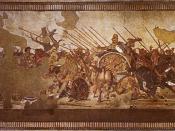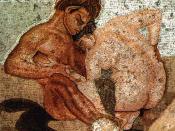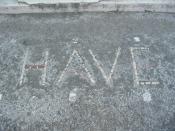The life of one family deduced by the ruins of their house in Pompeii.
The House of the Faun is the largest house inside the walls of Pompeii, that has been found under the layers of lava and ash which 'froze' the city about 1800 years ago. It was first discovered by the German archaeologist August Von Goethe in the 1830's and was later named after him as the House of Goethe. It was later fully excavated by the famous archaeologist Matteo Della Corte in the early 20th Century. The House was later renamed after the dancing faun in the middle of the Impluvian, in the Main Atrium, The House of the Faun. Inside there are many mosaics and structures carved and created in the first style. I will be looking at these to try to deduce the lifestyle of the family living in the House of the Faun.
The outside of the House, which now lies in ruins, must have been a fairly commanding sight to see, as the house is much larger than any of the surrounding houses, as it took up a whole block. The house is situated near the political centre of Pompeii, known as The Forum. This shows us that the family must have been wealthy, well respected with some social standings in the community.
Outside the House, just before the Vestibule there is the Roman equivalent of a welcome mat. It was created by using small, red, white and blue tiles in a mosaic. The welcome mat bears the Latin greeting 'Have' (pronounced 'ave-ay). The meaning, roughly translated is Welcome or Greetings. We can tell all of this as the 'mat' is still fairly well preserved. The overall feel of the House indicates that the family was concerned of the overall impression...


